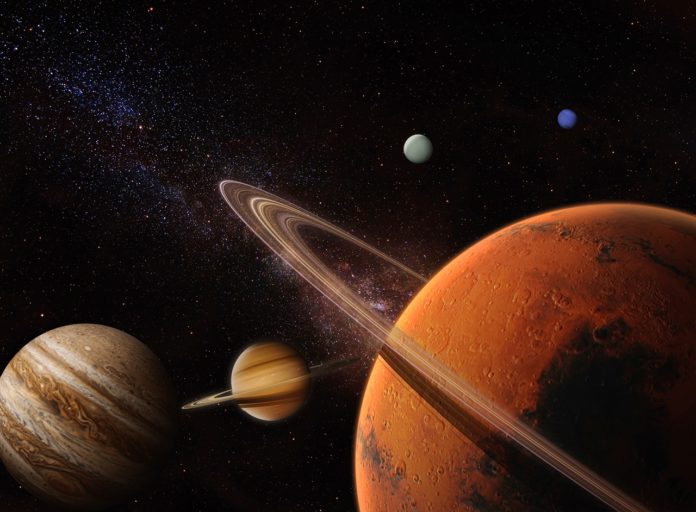Mars, the fourth planet in our solar system, is the most widely searched planet for life. Like Saturn, Mars does not have any rings, but a new groundbreaking study suggests that Mars has had a ring billions of years ago.
Mars has two small, misshapen moons named Phobos and Deimos. However, their peculiar orbits hide important secrets about their past. The orbit of the smaller, more distant moon Deimos is tilted by two degrees.
Lead author Matija Ćuk, a research scientist at the SETI Institute, said, “The fact that Deimos’s orbit is not exactly in the plane with Mars’s equator was considered unimportant, and nobody cared to try to explain it. But once we had a big new idea and we looked at it with new eyes, Deimos’s orbital tilt revealed its big secret.”
In 2017, a pair of researchers theorized that Mars, too, once had a ring. After conducting several simulations, they found that Mars’s inner moon, Phobos, is losing height as its tiny gravity is interacting with the looming Martian globe.
Soon, it was estimated that moon Phobos will crash into Mars in several years, possibly creating a ring system afterward.
Scientists proposed that over billions of years, generations of Martian moons were destroyed into rings. Each time, the ring would then give rise to a new, smaller moon to repeat the cycle over again.
This cyclic Martian moon theory has one crucial element that makes Deimos’s tilt possible: a new moon would move away from the ring and Mars, which is in the opposite direction from the inward spiral Phobos is experiencing due to gravitational interactions with Mars. An outward-migrating moon just outside the rings can encounter a so-called orbital resonance, in which Deimos’s orbital period is three times that of the other moon.
Scientists noted, “These orbital resonances are picky but predictable about the direction in which they are crossed. We can tell that only an outward-moving moon could have strongly affected Deimos, which means that Mars must have had a ring pushing the inner moon outward.”
Scientists concluded that this moon might be 20 times as massive as Phobos. Also, its grandparent” existing just over 3 billion years ago, which was followed by two more ring-moon cycles, with the latest moon being Phobos.
Scientists think that this insight from the moon’s orbit has some significant consequences for our understanding of Mars and its moons. The discovery of the previous orbital resonance all, but refers to the cyclic ring-moon theory for Mars. Meanwhile, for much of its history, Mars possessed a prominent ring.
Scientists noted, “These theories may be up for some serious testing in a few years, as Japanese space agency JAXA plans to send a spacecraft to Phobos in 2024, which would collect samples from the moon’s surface and bring them back to Earth.”
Lead author Matija Ćuk, a research scientist at the SETI Institute said, “This will give us firm answers about the murky past of the Martian moons: I do theoretical calculations for a living, and they are good, but getting them tested against the real world now and then is even better.”
Journal Reference:
- Matija Ćuk et al., Evidence for a Past Martian Ring from the Orbital Inclination of Deimos. arXiv:2006.00645
